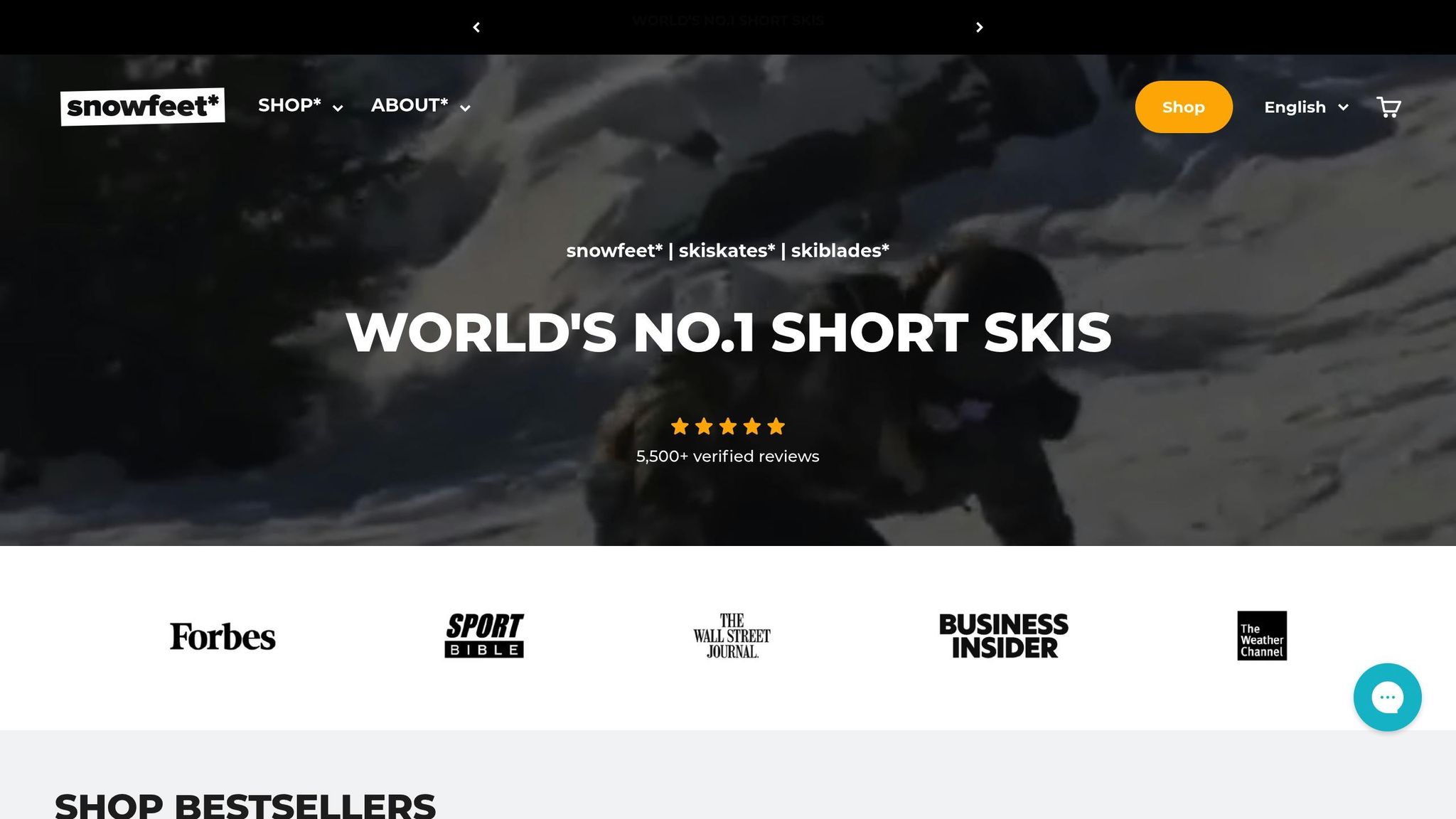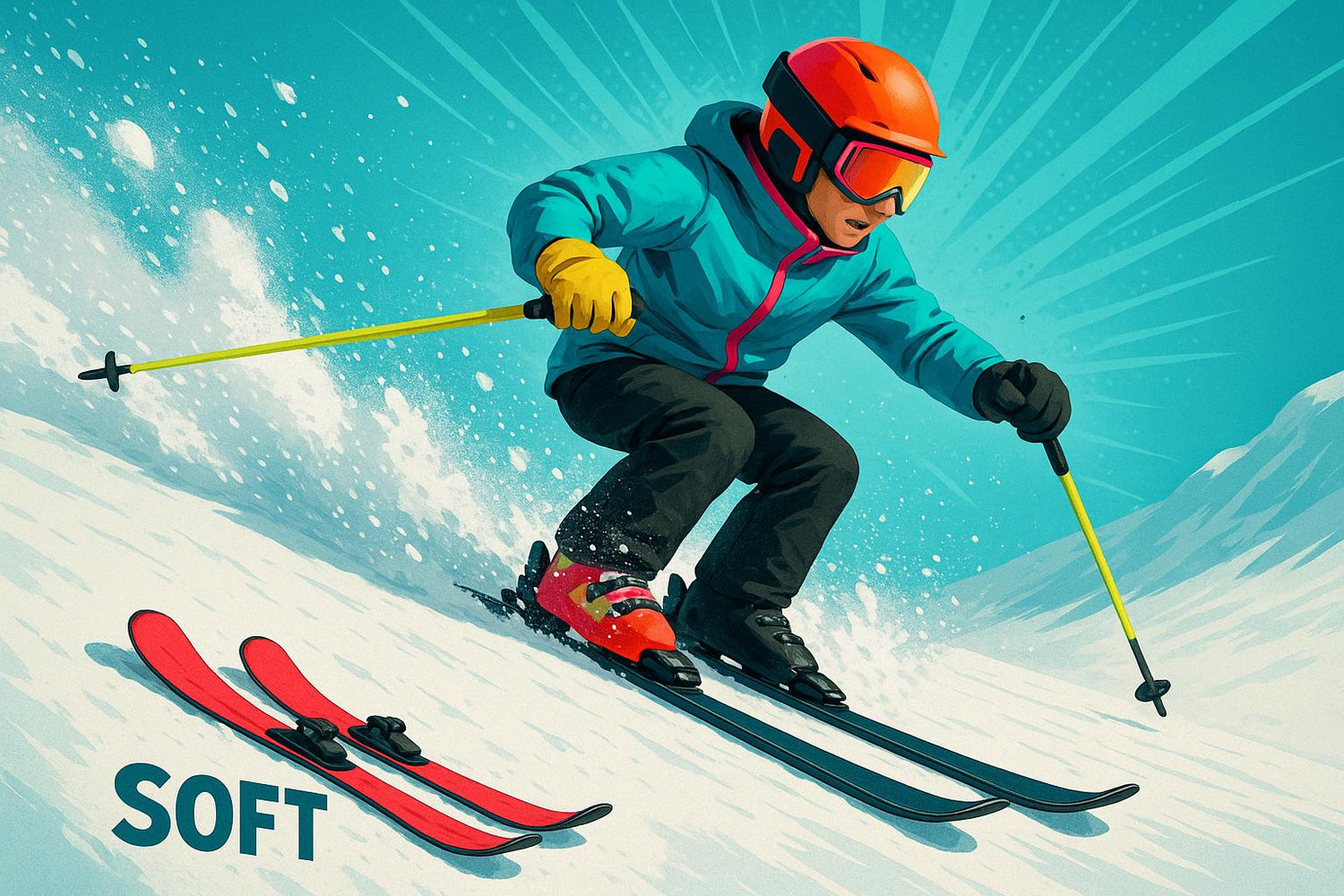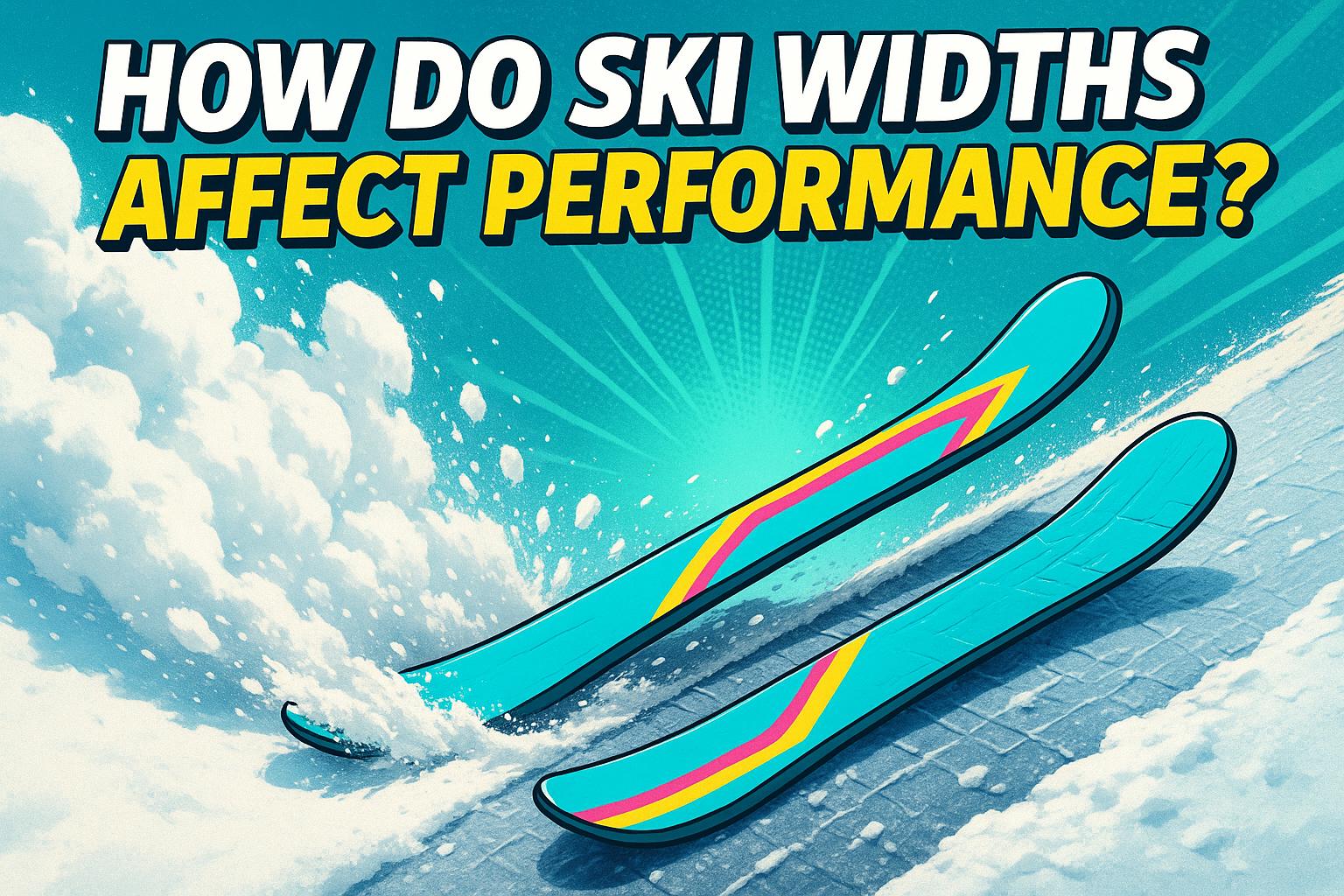スキーを選ぶとき、フレックス(曲がりやすさや硬さ)は性能に大きく影響します。知っておくべきことは:
- Soft Flex Skis:初心者に適しており、使いやすく、楽しいトリックや荒れた地形に最適です。よく曲がりますが、あまり速くはありません。
- Stiff Flex Skis:上級者向けで、高速でもしっかりとした安定した滑りができ、硬い雪や大きな斜面に最適です。ただし、ターンは難しいです。
簡単見分け表
| タイプ | やわらかめのフレックススキー | 硬めのフレックススキー |
|---|---|---|
| おすすめ | 初心者向け、トリック、でこぼこ | 長所、速い滑走、硬い雪 |
| 使いやすさ | 操作が簡単 | 鋭くて、技術が必要 |
| 高速時のホールド | あまりない | 多い |
| 地面 | 柔らかい雪、でこぼこ地形 | 硬い雪、滑りやすい丘 |
| 必要な労力 | あまりない | たくさん |
両方の良さを求めるなら、Snowfeet Skiblades と Mini Skatesは、柔らかいスキーの素早い動きと硬いスキーの強いホールド力を、小さくて持ち運びやすい形でミックスしています。
装備を知ろう - スキーのしなりとは?
スキーのしなりがパフォーマンスに与える影響
スキーのしなりは、コントロール、スピード、安定した動き、地面の種類、トリックにおいて重要な役割を果たします。詳しく見ていきましょう。
コントロールとパワームーブ
硬いスキーは曲げるのにより多くの労力が必要ですが、正確な動きで報われます。RenounのCyrus Schenckが言うように:
"硬いスキーは曲げるのにより多くのエネルギーが必要ですが、その分ターンやコントロールで報われます。逆に、柔らかいスキーは曲げやすいですが、同じエネルギーを返してはくれません。与えたものが返ってくるのです。"
一方で、柔らかいスキーは動かしやすく優しいため、新しいスキーヤーやゆったりとしたスキーを楽しみたい人に最適です。しかし、より大胆なスキーヤーが求めるようなキック感やコントロールは得られません。この差は、高速や混合地形でのスキーの挙動にも影響します。
スピードと安定性
硬い雪を高速で滑るなら、硬いスキーが最高の相棒です。しっかりと安定し、エッジが完全に接地し、跳ねやノイズを減らします。一方、柔らかいスキーは操作が簡単ですが、高速ではふらつく感じがすることがあります。
地形のナビゲーション
スキーのしなりは、さまざまな地形にスキーがどれだけフィットするかを決めます。硬いスキーは硬い雪に最適で、ターン中に地面をしっかりと捉えます。しかし、でこぼこや荒れた地形では、柔らかいスキーが優れています。衝撃をよく吸収し、ターンの開始と停止を簡単にします。Wagner Custom Skisはまさにその通りに表現しています:
"一般的に言えば、硬いフレックスのスキーはスピード時に安定し、硬い雪上での精度が高いと感じられます。硬いスキーはエッジがしっかり接地し、雪から跳ね返らないため、硬い雪でのグリップも良いです。しかし、硬すぎるスキーは体を揺さぶり、太ももを疲れさせます… 柔らかいスキーはターンの開始と解除が簡単で、凸凹でも寛容に感じられます。"
フリースタイルスキーでは、素早く柔軟に動くことが鍵です。
フリースタイルとトリックの動き
フリースタイルスキーでは、柔らかい曲がりが最高です。着地を滑らかにし、ジャンプやレールでのコントロールを助け、空中でのトリックを簡単にします。また、全体的に同じ曲がりを持つことで、前向きと後ろ向き(スイッチライディングに必要)両方で快適に滑ることができます。
ここで Snowfeet* のアイテムが輝きます。Rossignol や Atomic のような古いスキーとは違い、Snowfeet* Skiskates と Skiblades は44cmから120cmの短いサイズがあります。この設計により、あなたの動きに非常に素早く反応し、速い動きに適した柔らかい曲がりと、強いエッジホールドのための十分な硬さを組み合わせています。その小さなサイズはスノーパークだけでなく、狭い歩道にも最適で、古いスキーにはない優位性をもたらします。
1. ソフトフレックススキー
ソフトフレックススキーは、滑らかで簡単にスキーを楽しみたい人に最適です。圧力に対してよく曲がり、動きに素早く反応します。これにより、落ち着いてコントロールされた滑りを求めるスキーヤーにとってトップの選択肢となります。
コントロールと扱いやすさ
ソフトフレックススキーの大きな利点は、その使いやすさです。扱いやすく、ターンの開始や終了にあまり力を必要としないため、新しいスキーヤーに理想的です。研究によると、新しいスキーヤーは女性で約85、男性で100の柔らかいフレックス評価の方がターンが簡単でミスが減るため、より良い結果を出しています。この扱いやすさは、素早い修正が必要なときでも安定感を保ちます。Rossignol や Atomic のような大手ブランドにもソフトフレックスの選択肢はありますが、彼らのスキーは特に初心者にとって重くて扱いにくいことがあります。ここでソフトフレックススキーが際立ちます—扱いやすく、乗って楽しいのです。
トリックとフリースタイルに最適
フリースタイルスキーが好きなら、ソフトフレックススキーが最適です。曲がりやすさが着地を柔らかくし、スピンを簡単にして、ジャンプやターンなどのクールなトリックに挑戦する後押しをしてくれます。まるで雪の上でスケートしているよう!Snowfeet* Skiskates と Mini Ski Skates はこの楽しさのために作られています。軽量でスピンの重さを減らすように設計されているため、スピンが簡単に感じられ、膝や足首への負担も軽減されます。スノーパークにいるときも、フリースタイルの動きを試しているときも、これらのスキーはすべてを簡単に感じさせてくれます。
様々な地形に強い
ソフトフレックスのスキーはトリックだけでなく、荒れた地形でも優れています。しなりがあるため、バンプやモーグル、荒れた雪を越えるのが簡単です。硬い地面でもターンや方向転換が楽にできます。Snowfeet*のギアは小型で、整備されたコース、スノーパーク、トレイル、小さな丘にも適しています。約4インチ(10cm)までのパウダーも扱えるため、様々な雪質に対応できる頼もしい選択肢です。
持ち運びやすさ
そして最後の特典:持ち運びが簡単です。Snowfeet* Mini Ski Skatesは長さわずか15インチ(38cm)で、通常のスキーに比べて持ち運びが非常に楽です。長いタイプでも47インチ(120cm)と、移動の手間が大幅に軽減されます。隠れた丘へ歩いて行く時や、短い雪の旅の準備をする時、その小さなサイズが大いに役立ちます。
ソフトフレックスのスキー、特にSnowfeet*のものは、技術、様々な地形での使用、扱いやすさを兼ね備えています。簡単で楽しい滑りを求めるスキーヤーに最適で、持ち運びも簡単です。
sbb-itb-17ade95
2. 硬い曲げのスキー
硬い曲げのスキーは柔らかい曲げのスキーのようにしなりません。正確で力強い滑りを求めるスキーヤー向けに作られています。限界に挑戦したい方に最適で、優れたコントロールと耐久性を持ち、特に高速時にその力を発揮します。怖がりな方には向きませんが、毎回良い滑りを目指す方にぴったりです。
保持力と素早い反応
硬い曲げのスキーは、特に硬い雪上で安定性と正確さを保つのに最適です。その硬い作りによりエッジを完全に使い、跳ね返りを減らし、強いグリップを維持します。
"一般的に、硬いフレックスのスキーは高速時に安定感があり、硬い雪上での精度が高いと感じられます。" - Wagner Skis
これらのスキーは最高のパフォーマンスを目指し、すべての力を速く鋭いターンに注ぎ込みます。しかし、この素早い動作はスキーヤーに多くを要求し、時間が経つにつれて疲労を感じるかもしれません。
背が高い、体重が重い、または非常に力強い方には、曲げにくいスキーが合うことがあります。まだ慣れていなくても、その強固な作りが大胆なスキーに必要なサポートを提供します。これにより、最も厳しい地面でも確実なステップが可能になります。
移動する
硬いスキーは厳しい地形に最適です。氷の斜面、急な落ち込み、狭い雪道を思い浮かべてください。しっかりとした作りで操作性が良く、簡単に切り裂くように進めます。
レーススキーは高度なスキーテクノロジーを誇示します。例えばAtomic Redsterは、衝撃や振動を軽減するRevoshockテクノロジーを搭載し、滑らかな加速とターン時の安定感を実現しています。また、トップスポーツ選手向けに作られたRossignol Heroは世界FISルールに準拠しており、高い技術を持つ方に最適な選択肢です。
それでも、硬いスキーは初心者向けではありません。技術と体力が必要で、特に混合地形ではなおさらです。ジップとパワーで知られるVölkl Racetigerのようなタイプは、簡単であまり硬くないものを求める楽しむスキーヤーには強すぎるかもしれません。
持ち運びやすさ
一般的な硬いスキーの悪い点の一つは、その大きさと重さで、特にレースタイプはスキーヤーと同じかそれ以上の大きさがあります。動かすのが大変です。
ここでSnowfeet*が登場し、硬いスキーの性能とより簡単な扱いを新たに提案します。彼らのSkibladesはわずか65cm(約26インチ)で、硬いスキーの確かなホールドとリードを軽量で融合しています。99cm(39インチ)の長めのモデルでも雪上での良好なホールドと長いカーブを提供し、Atomic、Rossignol、またはHeadのような旧来のスキーよりもはるかに動かしやすいです。
動きやすさで最高を求めるなら、Snowfeet* Mini Ski Skatesが勝ちます。バッグに入る小ささで、硬いスキーのリードを持ちながら大きなスキーを運ぶ必要がありません。
硬いスキーの鋭いホールド感と安定感は欲しいけど大きさは嫌、というならSnowfeet*が最高の解決策です。大きなスキーのトラブルなしに強力なショーをもたらします。
良い点と悪い点
柔らかいフレックスと硬いフレックスのスキーを選ぶとき、その選択はしばしばあなたの滑り方や技量に依存します。それぞれに良い点と欠点があります。見てみましょう。
柔らかいフレックスのスキーは使いやすいと見なされ、特にターンの開始時に優れています。凸凹や荒れた場所をよく吸収し、柔らかい乗り心地を提供します。Wagner Custom Skisはこう述べています:
"柔らかいスキーはターンの開始と解除が容易で、凸凹に対しても寛容に感じられます。しかし、スキーが柔らかすぎると「ハンドルバーを越えて転ぶ」感覚を覚え、自信を持てず上達も難しくなります。柔らかいスキーは高速時に安定感が低く、硬い雪面でのグリップも劣ります。"
柔らかいフレックスのスキーは初心者や優しく楽しい乗り心地を求める人に好まれます。しかし、高速では安定感に欠け、氷雪でのグリップを保つのが難しいことがあります。
一方で、硬いフレックスのスキーはコントロールと鋭いターンのために作られており、熟練スキーヤーに愛されています。ターンでより多くのパワーを保持し、抜け出すときに強い推進力を与えます。r/SkiRacingのあるユーザーはこう言いました:
"硬いスキーはキャンバーを最大限に活かし、次のターンへの加速を高めるために、より高速かつタイトなターンが必要です。"
とはいえ、硬いスキーは曲げるのにより多くの力が必要で、それが筋肉の疲労を招くことがあります。Wagner Custom Skisも次のように警告しています:
"硬すぎるスキーはあなたを振り回し、太ももの筋肉を疲れさせます。"
これら二つがどのようにマッチするか見てみましょう:
| 特徴 | やわらかめのフレックススキー | 硬めのフレックススキー |
|---|---|---|
| 最適な用途 | 初心者、軽いスキーヤー、トリック、でこぼこ | 上級スキーヤー、速い滑走、鋭いターン、レース |
| ターンの開始 | やわらかい | 硬い |
| 動かしやすさ | 高い | 低い |
| 高速時の安定性 | 高速ではあまり得意でない | 高速での性能が良い |
| 使いやすさ | より気楽 | 硬め |
| 雪のタイプ | やわらかい雪、でこぼこ | 硬い雪、混合雪 |
| 必要な努力 | 少なくする | もっと見る |
Snowfeet*の2つのミックス

Snowfeet*はハードスキーとソフトスキーの良さをミックスしたスキーギアを作っています。例えばSnowfeet* Skibladesは、わずか65cm(26インチ)で、ハードスキーのような鋭いターンとグリップを提供しつつ、あまり上級でないスキーヤーにも使いやすいです。AtomicやRossignolのような大手ブランドのスキーとは違い、Snowfeet*は新しいスキーヤーからトップスキーヤーまで疲れにくいフレックスを実現しています。
Snowfeet* Mini Ski Skatesはさらに一歩進んでいます。短いサイズで扱いやすく楽しいだけでなく、確かなカットに耐えうる強さも備えています。まるでソフトスキーの軽さとハードスキーのグリップの両方を手に入れたようなもので、バッグに収まるセットです。
通常のスキー感覚を求める人には、99cmのSnowfeet*スタイルが大きなスキーの感覚を与えつつ、サイズは控えめです。パークで新しい動きを試すときも、よく整備されたコースで広いターンをするときも、これらのスキーは一つのスタイルに縛られずに動きを試せます。さらに、HeadやVölklのような大きなブランドのスキーよりも持ち運びがずっと楽です。
まとめ
あなたのスキーに最適なフレックスは、あなたの滑り方、知識、そして山でやりたいことに合っています。足の専門医であり優れたスキーブーツフィッターのDr. Ned Buckleyはこう言っています:
「フレックスの選択は、各ブーツが発揮するパフォーマンスにとって非常に重要であり、スキーヤーのレベル、種目、体重に基づいて選ばれます。」
初心者や簡単で楽しいライドを好む人には、ソフトフレックススキーがおすすめです。一方で、硬いフレックススキーは速いカットのために鋭く強い動きが必要な上級者に向いています。しかし重要なのは、多くのスキーヤーが雪質やパワーの変化に応じて一日中ニーズが変わるということです。
そこがSnowfeet*の輝くところです。ひとつのフレックスに縛られるのではなく、Snowfeet*はさまざまなスキータイムに合うギアを提供します。例えば65cmのSkibladesは、速くてタイトなターンに最適ですが、強いカットにも対応します。また、99cmタイプは確かな感触と楽しい変化の良いバランスを見つけています。
RossignolやAtomicのような通常の固定フレックススキーとは違い、Snowfeet*ギアはさまざまな地形を楽にこなせるように作られています。初めてのターンでも、パークで新しい動きを試すときでも、Snowfeet*スキーのショートサイズと均一なフレックスがすべてを簡単に感じさせます。さらに、わずか150ドルからのMini Ski Skatesなら、手頃な価格で変化を楽しめるスキーが手に入ります。

































コメントを残す
このサイトはhCaptchaによって保護されており、hCaptchaプライバシーポリシーおよび利用規約が適用されます。